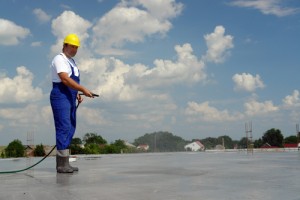In order to finish a project with a strong, flat and smooth slab of concrete, you need to use the process of care known as curing. For many, curing refers only to maintaining moisture on the new concrete’s surface, but there’s actually more to it. Proper curing is what allows cement and water to bond and react properly. Here’s a basic curing primer to ensure you’re next concrete project goes off with a hitch.
- 3 Curing Methods
After properly mixing and pouring your new concrete, there should be plenty of water present. But, at the surface, this water will begin to dry-out, which calls for curing. There are three methods to cure concrete. First, you can add water to the surface. This replaces the evaporating moisture and keeps the concrete’s water level constant. Second, you can seal the concrete to keep water from evaporating. This keeps the proper level of moisture in the concrete as it dries. The third method is to use both of the first two methods. Remember that regardless of which method you use, the water added isn’t meant to be mixed into the concrete.
- 3 Curing Phases
In order to keep your new slab of concrete at an acceptable temperature, usually between 50 and 85 degrees F, and at an acceptable moisture level, which varies, you’ll need to use the three phases of curing. Starting immediately after pouring the slab, watch the bleed water that rises to the top of your concrete. This water will continue to rise as the concrete sets, but if it’s evaporating faster than it’s rising and the level is dropping, you’ll need to start curing to avoid cracks. As the concrete dries, the second phase of curing is performed. Then, after the final set, the final phase of curing is done to complete your slab.
- The Effect of Temperature
Up to now, it may seem that the real obstacle standing between you and a perfect slab of concrete is moisture. That’s only half the battle, however. Because cement and water mixing to form cement is a chemical reaction, the temperature of the mix must be warm enough for the reaction to occur, but not so warm that it happens to rapidly. If the concrete gets below 40-degrees, it stops absorbing moisture. When temperatures rise over 85-degrees, the reaction moves so rapidly that the concrete sets before it’s truly ready. That results in a weak or brittle slab. Remember, the temperature referred to here is the temperature of the concrete mixture, not the surrounding air.
By understanding and following these basics of concrete curing, you can ensure a strong and smooth slab every time.
At Maxwell Supply in Tulsa, we carry everything you need for your next concrete project, including a wide variety of both water and chemical curing products. Give us a call, browse through our online store or stop by and see us.
